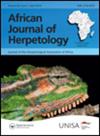斑点象自然种群甲壳鳞甲形态的广泛变异
IF 0.9
4区 生物学
Q3 ZOOLOGY
引用次数: 8
摘要
摘要现存龟类甲壳上鳞片的排列在种间非常相似,但种内鳞片与典型鳞片的偏离是常见的。由于种内变异可能与近交抑制、不利的卵孵化条件和环境污染物的存在有关,因此对自然种群中甲壳鳞片模式的研究可以增强对龟类生态学和生存挑战的认识。本文对生活在年降雨量变化较大的干旱地区的象龟(Homopus signatus)种群进行了取样,记录了甲壳鳞片的分布规律。典型特征是由5对椎板、4对肋板、1对颈板和1对尾骨上板以及12对边缘板组成。虽然预计大小类别(即代表不同年份出生的陆龟)和性别会因卵孵化条件的不同而与典型的鳞甲图案有不同的百分比偏差,但大小类别和性别之间的百分比是相似的。44%(如果排除相对可变的边缘鳞片的计数,则为25%)的龟具有异常的甲壳鳞片图案。由于研究种群位于相对原始的地区,并且多余的甲壳鳞片似乎与其他龟类的卵孵化条件有关,因此野生H. signatus甲壳鳞片模式的广泛变化可能是该物种在恶劣环境中经常挑战孵化条件的结果。本文章由计算机程序翻译,如有差异,请以英文原文为准。
Wide variation in carapacial scute patterns in a natural population of speckled tortoises, Homopus signatus
Abstract The arrangement of scutes on the carapaces of extant chelonians is very similar among species, but intraspecific deviations from typical scute patterns are common. Because intraspecific variation may relate to inbreeding depression, unfavourable egg incubation conditions and the presence of environmental pollutants, investigations of carapacial scute patterns in natural populations can enhance insight into the ecologies and survival challenges of chelonians. A population of the tortoise Homopus signatus, inhabiting an arid range with substantial annual rainfall variation, was sampled to record carapacial scute patterns. The typical pattern of H. signatus consisted of five vertebral scutes, four pairs of costal scutes, a cervical and a supracaudal scute, and 12 pairs of marginal scutes. Although it was expected that size classes (i.e. representing tortoises born in different years) and sexes would have different percentages deviations from the typical scute pattern as a result of different egg incubation conditions, percentages were similar among size classes and sexes. A high percentage of 44% (25% if counts of the relatively variable marginal scutes were excluded) of all tortoises had deviant carapacial scute patterns. Since the study population was situated in a relatively pristine area and supernumerary carapacial scutes appear related to egg incubation conditions in other chelonians, the wide variation in carapacial scute patterns in wild H. signatus may be the result of frequently challenging incubation conditions in the species’ harsh environment.
求助全文
通过发布文献求助,成功后即可免费获取论文全文。
去求助
来源期刊

African Journal of Herpetology
ZOOLOGY-
CiteScore
3.00
自引率
6.70%
发文量
15
审稿时长
>12 weeks
期刊介绍:
African Journal of Herpetology (AJH) serves as an outlet for original research on the biology of African amphibians and reptiles. AJH is an interdisciplinary journal that publishes original articles and reviews from diverse fields and disciplines, such as conservation, phylogenetics, evolution, systematics, performance, physiology, ecology, behavioural ecology, ethology, and morphology.
The Journal publishes two issues a year. There are no page charges .
 求助内容:
求助内容: 应助结果提醒方式:
应助结果提醒方式:


